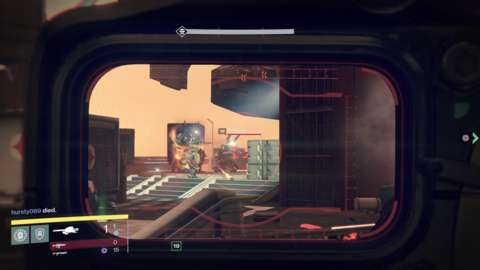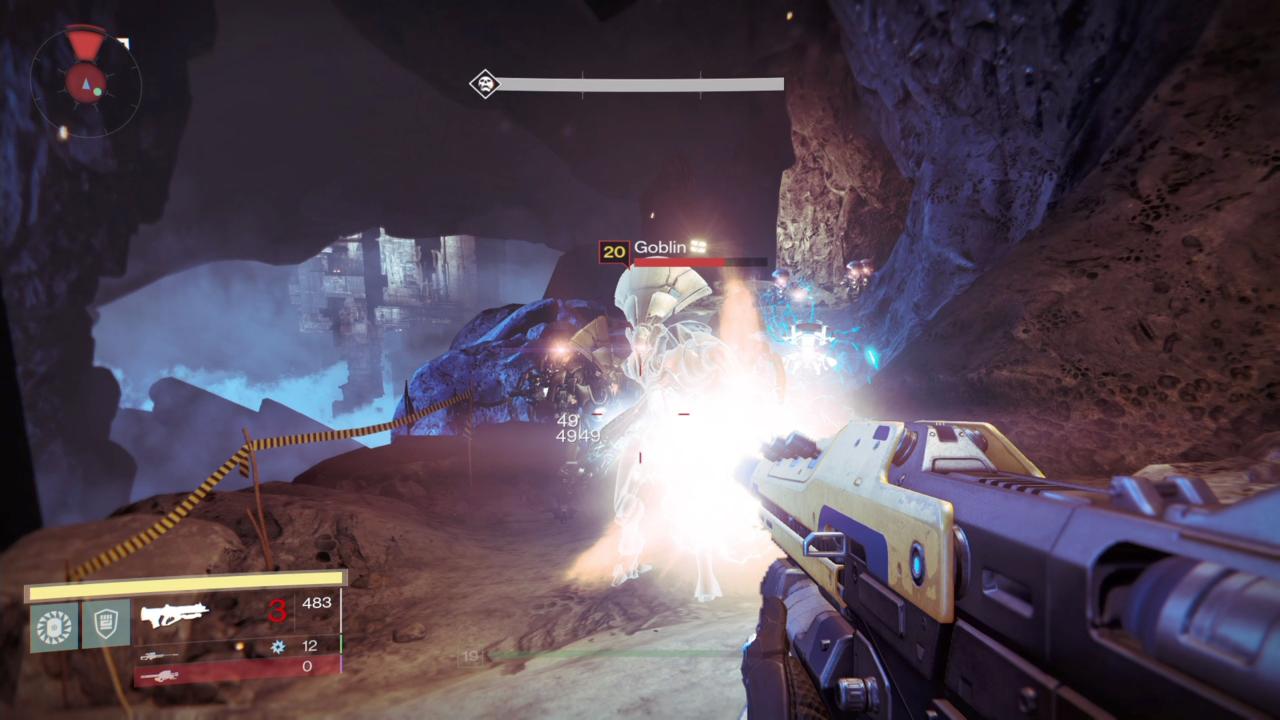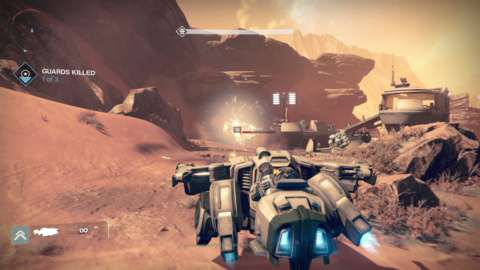It's called the Black Garden. You see it from a clifftop above, gazing across the blooming acres through a thick green haze, and imagine the sights that might be seen there, and the adventures you might have there. The reality of the garden is sadly never better than the stories you might make up in your head when you look down at it. What you see is a facade; the garden is a broken promise of adventures you never have and landscapes never explored, and it represents the whole of Destiny, a multiplayer shooter that cobbles together elements of massively multiplayer games but overlooks the lessons developers of such games learned many years ago. I dream of the tales that might one day be told in that sprawling expanse, but Destiny is not yet telling them.
Instead, Destiny prefers telling the same pedestrian stories time and time again, hoping to transfix you with its rinse-and-repeat pace and ply you with the possibility of better loot, rather than with gameplay diversity that gives you good reason to hope for surprises on the horizon. Cooperative missions--some of them occurring within the story, and others, called strikes, occurring outside of it--are primarily about doors and computers. Your robotic companion, an orb voiced by Game of Thrones actor Peter Dinklage, hacks into a lot of them, and it is your job to shoot aliens hailing from various galactic races while he drones the occasional word of encouragement. ("I'll work faster," he says, in a bored not-quite-robot, not-quite human delivery that, like most of Destiny, lacks energy and charisma.) The fight may end with an elite enemy, or even a giant boss, that absorbs many minutes worth of bullet fire before it falls, just in time for Dinklage-bot to announce his success and open the door that leads to another firefight and another terminal to hack into.
The repetition may not bother you at first. It's easy to be taken in by Destiny's gorgeous shell, a slick and striking wrapper that surrounds the hollow and unimaginative game languishing inside of it. Everything about the game screams "big budget," and Destiny's versions of Earth, Mars, the Moon, and Venus are meant to be ogled and appreciated. Outside of the pockets of alien invaders and the dropships that bring you even more strange entities to annihilate, these are sterile places, more like stunning screensavers than dynamic domains. But what views Destiny offers! From the golden-red sands of Mars rise rocky crags and abandoned facilities that speak to a history the story offers too few glimpses into. On Venus, you might hesitate to step foot into streams of unknown purple liquid that couldn't exist on the planet as we currently understand it. These sights are awe-inspiring, though Destiny takes a "look but don't touch" approach to them. That purple liquid? It's fine to walk through. Destiny's environments are oblivious to your presence, more cold and indifferent than hostile and mysterious.
Make no mistake: Destiny's mechanical basics are, for the most part, superb. Interacting with this online-only shooter is a delight. The confident shooting model, the intuitive menus, the unblemished frame rate--all of these elements make for a fantastic foundation to build a worthy dynamic multiplayer shooter upon. Pulse rifles shoot their rhythmic barrages with great power, and charging up a fusion rifle and releasing its payload is akin to holding your breath and then expelling it in one rewarding sigh. The game's best combat feature, however, might be its melee attack, regardless of which of the game's three all-too-similar classes you choose. Destiny nails that special, difficult-to-define something comprised of fluid controls, excellent collision detection, and awesome technology that makes every action silky and responsive. You can leap and glide through the air, a mechanic that gives Destiny a sense of freedom that matches its open spaces, and helps you escape danger when encounters get tough.

The most powerful foes put up a decent fight, using cover to their advantage, protecting themselves with shields, or assailing you en masse. If only you got access to the aliens' intriguing firearms instead of being confined to the game's excellent but bog-standard arsenal. Luckily, you gain access to different types of slow-to-replenish grenades, and a few superpowers, such as the warlock's magical area-of-effect projectile, that take even longer to recharge. The extraterrestrial races you battle come in all shapes and sizes and yank their names from the Dungeons & Dragons rulebook: wizard, minotaur, harpy, and the like. Tearing down the alien hordes can be enjoyable. You set the sights of your machine gun on a chain of thralls and mow them down while a troop of acolytes fires on you from a distance. The stage is set for an electrifying showdown.
The disappointment of Destiny is that it fails to capitalize on the possibilities. Story missions and strike missions have you taking to Destiny's broad and beautiful settings with a friend or two at your side, but breadth isn't the games primary calling card: it's repetition. Excellent basics are betrayed by half-baked ideas stretched into hours of slow-paced and redundant tasks that have you asking yourself, "Hey, isn't this the same canyon I just raced through on my handy speeder a few moments ago? Hey, didn't I just cross this hill 10 minutes ago, and 20 minutes ago, and an hour ago?" It's tempting to compare Destiny to full-fledged massively multiplayer role-playing games, but doing so reveals how much more diverse typical MMOGs really are. By contrast, Destiny makes no attempt to mask the sameness of its primary tasks. To pursue new content in Destiny is to fondly recall a trophy you've already won. It's nice to relive the victory, but new celebrations require new victories, not home movies of the old ones.

Destiny tries to mask its repetitiveness with a vague story that uses more cryptoscientific nonsense than an entire season of Star Trek, and grants your character so meaningless an identity, and so little dialogue, that he or she might as well be a silent protagonist. "Lure out the Vex Gate Lord that protects the Endless Steps and bring its head back to the Awoken," says the mission text, making you ponder phenomena you know next to nothing about. What is the role of the Awoken in this solar system? What is the historical relevance of the Endless Steps? What purpose drives the Vex, and indeed, what do the Awoken hope to learn?
I don't have the answers.
The story hints at its potential about halfway through, when you meet two of Destiny's few non-Dinklage characters, both of whom wear dramatic costumes and fill their speech with pregnant pauses worthy of the best Bond villains. Alas, Destiny wastes the opportunity to develop a mystery worth caring about, and instead reverts to more fetch quests, then follows them up with a manipulative ending that reminds you that the game's superlative orchestral soundtrack does far more work in establishing this world's tone than the mediocre writing ever does. To be fair, some of the item descriptions, and lore-heavy explanations you can read on Destiny's official website, fill in some narrative gaps. But even many of those explanations require you to meet certain thresholds so that you can unlock them. Developer Bungie doesn't take responsibility for its own story; instead, it passes the responsibility for learning the story on to you, but never infuses its game with the richness of tone that might inspire you to seek answers.

There's loot, of course, much of it in the form of new weapons, armor, and blueprints called engrams, which you redeem at a hub called the Tower. You share this space with a dozen-plus other players, most of whom talk to the vendors there without concern for other players. If you're used to the barrage of loot you receive while playing games like Borderlands or Diablo III, be sure to prepare for Destiny's slower pace of doling out rewards. It's befitting that meaningful new stuff doesn't come that frequently, given how Destiny on the whole feels like a standard-sized experience stretched entirely too thin. Once you leave the tale behind, which happens about 15 hours into Destiny should you play story missions that match your level, your desire for loot is the biggest determining factor when deciding whether to stick with Destiny or to jump ship.
I'm not sure I will return, in spite of the promise of a larger-scale raid event soon to come. Each automatic rifle is more or less like the last, and the various passive upgrades do little to spur my interest. Much of Destiny feels underdone and underthought. There's no scaling system in place to allow players of too-disparate levels to play together, or even to draw you back to lower-level areas. The presence of players outside of your fireteam is more window dressing than vital mechanic, particularly if you level up in ways that don't involve performing patrol missions, which return you to previously explored areas to perform random, boring quests. It is on patrol missions that you stumble upon public events, which draw nearby players together to vanquish greater foes, like a hardy spider tank that soaks up rockets and heavy fire. Given Destiny's habit of delivering small-scale action in a large-scale world, it's a shame it's so easy to miss out on these events: they are one of the few elements that make Destiny spring to life.
Destiny prefers telling the same stories time and time again, hoping to transfix you with its rinse-and-repeat pace and ply you with the possibility of better loot, rather than with gameplay diversity that intimates surprises hovering on the horizon.

The crucible is where the action heats up, even if it rarely erupts with true thrills. This is where Destiny's competitive multiplayer lurks, and it's entirely competent. A post-Halo Bungie reminds us once again of its mastery of level design, with intricate maps of various sizes that get put to good use in four different modes. Six-member free-for-all deathmatch finds its stride on maps that recall the winding corridors and central combat arenas of Unreal Tournament, and gives you a good reason to wield a shotgun if you've gotten accustomed to equipping a sniper rifle in that secondary weapon slot. This six-player deathmatch also has a team variation, on which teams of three hunt each other at a more thoughtful pace than the other modes provide. It's best to stick with friends for this one: communication is key, as is carefully surveying the area before making moves that could put you directly in an opponent's line of sight. It's Destiny's tensest mode, but one that strangers can easily disrupt. Typical team deathmatches involve twice as many players on maps that sometimes allow you to leap into one of Destiny's two combat vehicles. (Oh, how I wish these vehicles had been put to better use outside of the crucible.)
Control mode, in which players seek to secure specified control points, is the most enjoyable, however, allowing both lone wolves and focused teams to contribute. There are some issues here, such as the way the auto-targeting can cause a passing opponent to grab your targeting reticle when you are trying to fire at a different target. However, competitive play proves itself a worthy way of leveling up and earning access to gear otherwise unavailable. The maps themselves eventually reveal subtle but clever details that become important tactical considerations. Those large space-age doors take a moment to open, and do so loudly enough that you might very well signal your approach. Mounted guns offer a view of the exact right amount of real estate, making a stationary gunner potentially valuable but by no means overpowered. If any attack is overpowered, it might be the arc blade, the bladedancer subclass's super ability, which cuts through you like a knife through space butter. (It's the gunslinger's golden gun ability that I most often succumb to, however.)
You might summarize Destiny by the way in which it wraps up its story. Once the final, hackneyed closing scene finishes, fireteam members are awarded the same weapon, regardless of class, and a handful of currency. This reminder of how wholly unspecial you are is the big finale of a lavishly produced but troubled game that excels in the basics but lacks creativity and heart. It is role-playing grind in shooter form--an empty house built on a firm foundation.